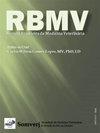感染Dirofilaria immitis的狗出现异常肺血栓栓塞
Q4 Veterinary
引用次数: 1
摘要
线虫Dirofialia immitis及其内共生体Wolbachia是犬心丝虫病的病原体。这种蠕虫的主要栖息地是肺动脉,肺动脉会引发炎症和凝血过程紊乱。临床症状因多种因素而异,包括蠕虫负担、个体反应和感染持续时间。本报告描述了一例罕见的继发于HW感染的肺血栓栓塞症。一只7岁的雌性腊肠犬有咳嗽、呼吸困难和两次晕厥的病史。体格检查,口腔黏膜轻度变色,股脉微弱,有呼吸窘迫,腹胀。超声心动图显示右房室和肺动脉严重增大,动脉内有一个高回声的大结构。狗自然死亡后,对其肺部和心脏进行了检查。在右心室只发现了一只蠕虫,在肺主动脉发现了一个大血栓。组织学上,纤维蛋白血栓和寄生虫碎片存在于肺动脉分支内。这些发现强调了对HW患者进行彻底临床评估的重要性,并证实只有少数蠕虫会威胁动物的生命。因此,一旦治疗危及生命,兽医必须加强化学预防。本文章由计算机程序翻译,如有差异,请以英文原文为准。
Unusual pulmonary thromboembolism in a Dirofilaria immitis infected dog
The nematode Dirofilaria immitis and its endosymbiont Wolbachia are the agents of canine heartworm (HW) disease. The worm´s main habitats are the pulmonary arteries, which elicit inflammation and disorders of the coagulation process. Clinical signs vary according to multiple factors, including worm burden, individual reaction, and duration of infection. This report describes an unusual case of pulmonary thromboembolism secondary to HW infection. A 7-year-old female dachshund presented with a history of cough, dyspnea, and two syncope episodes. On physical examination, the oral mucosa was slightly discolored, the femoral pulse was weak, respiratory distress was present, and the abdomen distended. Echocardiography showed severe right atrioventricular and pulmonary artery enlargement and a large structure with high echogenicity in the artery. After the dog died naturally, the lungs and heart were examined. Only one worm was found in the right ventricle, and a large thrombus was found in the main pulmonary artery. Histologically, fibrin thrombi and fragments of parasites were present inside the pulmonary artery branches. These findings highlight the importance of a thorough clinical evaluation of HW patients and confirm that only a few worms can threaten an animal’s life. Therefore, veterinarians must enforce chemoprophylaxis once treatment is life threatening.
求助全文
通过发布文献求助,成功后即可免费获取论文全文。
去求助
来源期刊
CiteScore
0.80
自引率
0.00%
发文量
34
审稿时长
>12 weeks
期刊介绍:
The Brazilian Journal of Veterinary Medicine was launched in 1979 as the official scientific periodical of the Sociedade de Medicina Veterinária do Estado do Rio de Janeiro (SOMVERJ). It is recognized by the Sociedade Brasileira de Medicina Veterinária (SBMV) and the Conselho Regional de Medicina Veterinária do Estado do Rio de Janeiro (CRMV-RJ).

 求助内容:
求助内容: 应助结果提醒方式:
应助结果提醒方式:


